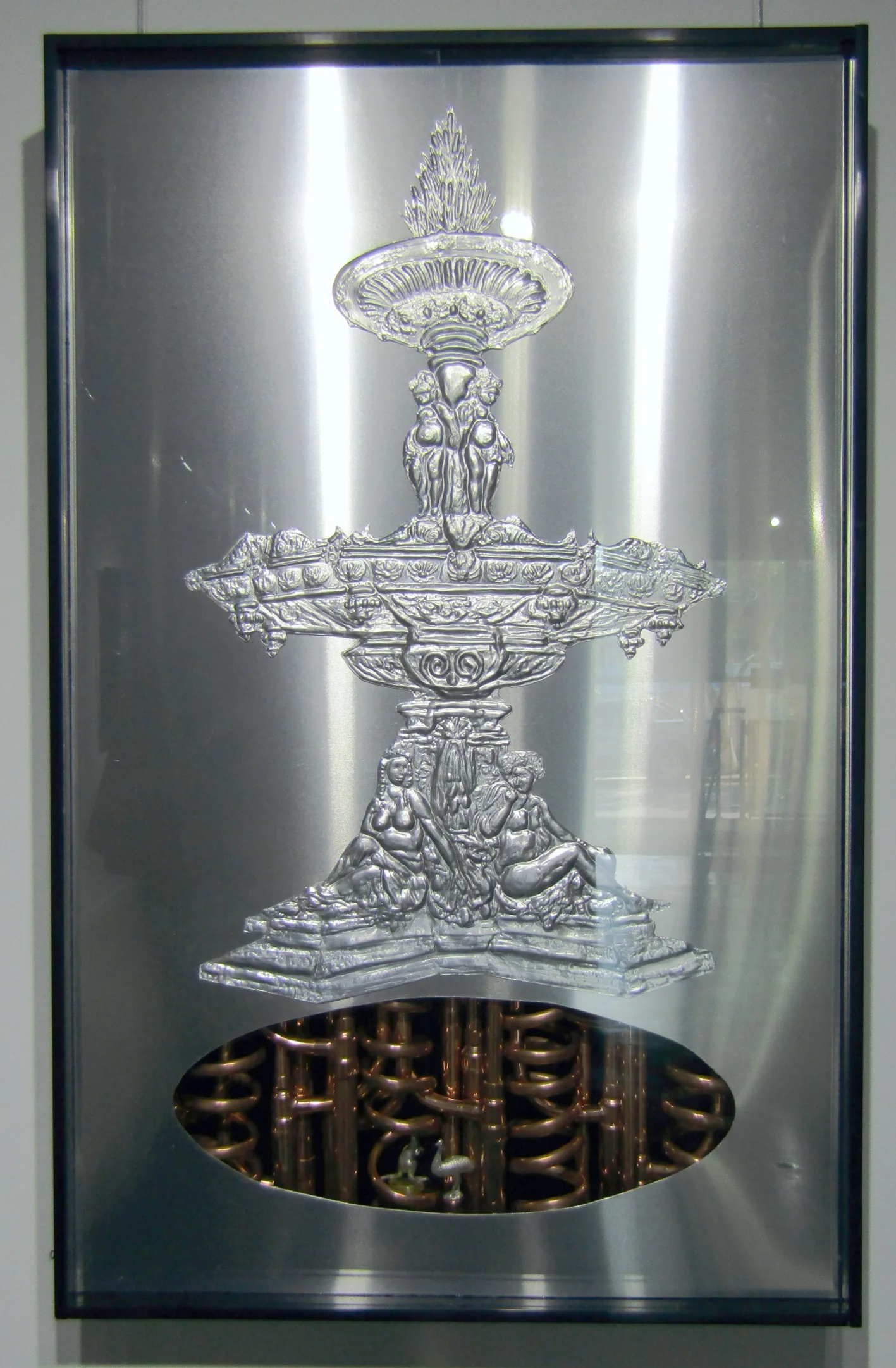Waterworks
In this series of works, Ross Woodrow takes a distinctly post-Duchampian and postcolonial perspective which pays due homage to the European tradition of the fountain without neglecting the Antipodean contribution to plumbing and aesthetics. In April 1917 the French artist, Marcel Duchamp, engineered a press scandal in New York by submitting a store-purchased urinal under the title of “Fountain” to an art exhibition. His only autographic contribution to the porcelain urinal was the addition of a painted signature, “R. Mutt.” Perhaps to insinuate the superiority of the European intellectual tradition, he justified this act of creative selection or readymade art with the statement: “The only works of art America has given [the world] are her plumbing and her bridges.”
Artists' Statement
These Waterworks were inspired by a series of etchings showing designs for fountains by the French designer Jean le Pautre (1618 – 1682). As far as I know, none of these fountains were ever built, although elements such as the dolphins and sea horses are common currency in fountains across the world. My first inclination to develop variations of these into large contemporary etchings using shaped copper plates, with embossing creating some sense of three-dimensionality, floundered on the fact that they would remain a direct etching-to-etching translation. Needless to say the next move to remove paper from the equation led to the evolution of the embossed aluminium technique, which opened up the possibilities that I have exploited here to create objects that don’t comfortably meet a singular definition as printmaking, sculptural fabrication or craft. The axiom, applied by Ernst Gombrich among many others, that the more art tried to escape looking like art the more it approached that condition, is no longer secure. There is probably nothing in digital or material production left in or outside the post medium field of contemporary art, not to mention the realm of the “Internet of Things” that can make the claim not to be art. The practice I’ve followed in making these Waterworks was the usual mix and match of materials, images and metaphors that will best encapsulate a visceral and aesthetic response to my seemingly simple theme of “fountain”. I wanted to evoke the profligate folly in the idea of the fountain but also to invert Duchamp’s selection of plumbing as the most remote polarity of non-art. I particularly sought to use the complex conceptualization of the fountain as a working wonder where the viewer suspends the knowledge of the hidden piping, pumps and pressure that makes it all happen as in the case of our own bodily “waterworks”. The fountain is a fundamentally Classical or European cultural signifier as demonstrated by its embrace by Las Vegas casinos and the fact that the form has limited impact in Australia. The Launceston fountain from 1858, which I’ve included in the exhibition, was an imported copy from the Paris Exhibition, 1855. The Antipodean associations of Australia with the European fount of civilization and the simultaneous imperial exploitation of the colony’s resources and disregarding of its inhabitants makes for an irresistible emphasis on the underworld. Much of the fauna that inhabits this world, not unexpectedly, is sourced from the nineteenth-century antipodean version of the scaled-down, substitutes for the exotic European fountain – silver epergnes, toast racks, serviette rings and cutlery that could signify civilized dining and cultivated taste while acknowledging that exoticism extended beyond using the fanciful dolphin or seahorse to hold up the shell-shaped silver salt. The Antipodean approach to formulating a stylistic aesthetic by substituting indigenous flora and fauna (and sometimes Indigenous people as well) for Classical inventions in their silver and gold tableware and jewellery was based on a combination of a no-nonsense attitude and attempts to forge an Australian identity. Only in retrospect can we see that this only reinforced the power of that Classical tradition. Even so, the failure of that enterprise fuels the nostalgia for a time when binary divisions such as civilized/uncivilized, profession/trade, art/non-art made sense. This is especially so today when it is generally water spouts alone (often with coloured lights) that make the spectacular fountains in cities everywhere. The stylistic vocabulary of the real and invented flora and fauna is mostly gone but of course the powerful technology of pipes and pumps that controls all the action remains hidden from view.
Ross Woodrow
Ross Woodrow Waterworks 15 Nov -- 3 Dec 2016
Bosz Gallery, 4/9 Doggett St Fortitude Valley, Brisbane Australia (Gallery opened in 2014 and closed in 2017
Above: Glover’s Untidy Eucalypt Scrub, 2016, embossed aluminium with fabricated elements in copper, brass and silver and gold alloy. 90 x 60 x 7cm.(private collection, Brisbane)
Hercules as Convict Plumber 100 x 60 x 7 cm. embossed aluminium with fabricated elements in copper, brass and silver and plastic mirror.
Detail
Sydney Water and the Garden Palace 100 x 60 x 7 cm. embossed aluminium with fabricated elements in copper, brass and silver, fabric and plastic mirror.
Installation views of Waterworks Exhibition
Installation view
Installation view
Installation view
Exquisite Upward Pressure (92 x 58 x 7 cm) embossed aluminium with fabricated elements in copper and electroplated silver. (Private collection, Brisbane, Australia)
Copyright © Ross Woodrow --All Rights Reserved












